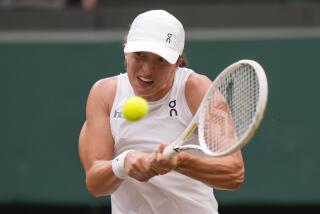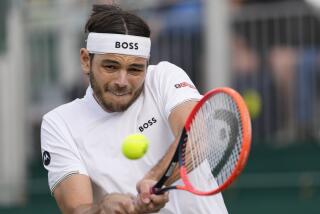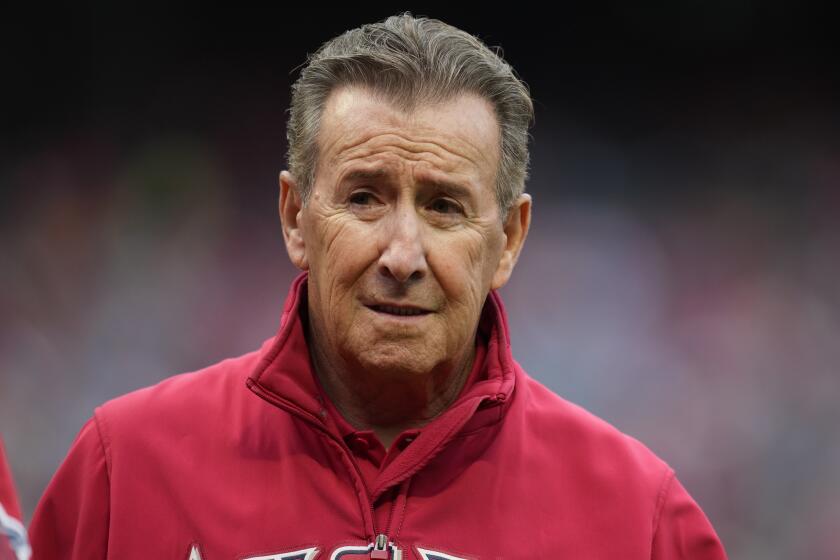Hard Times Ahead : After Winning on Grass at Wimbledon Pete Sampras Will Take a Difficult Road to the U.S. Open
It’s 18 days since Pete Sampras won at Wimbledon, and he still hasn’t unpacked everything. His Wimbledon trophy is still wrapped up in the box at his home in Tampa, Fla.
It’s a tidy conclusion to the most famous 14 days in tennis, which Sampras jokingly referred to as “the big W” before he took to the grass and mowed everybody down, winning his second Grand Slam title before his 22nd birthday.
So far, Sampras has put together a nice package. He has been ranked No. 1 since April 12. He has won 51 matches and five tournaments, more than anyone else on the IBM/ATP Tour. He won $462,044 at Wimbledon and has banked more than $1.34 million this year.
And it’s still July.
“To be honest, I’ve been on Cloud 9 ever since I woke up the Monday morning after winning it,” Sampras said. “Life was great. I’ve achieved something that not too many people have.”
According to 1938 Grand Slam winner Don Budge, Sampras belongs in a class by himself.
“He does everything right,” Budge said. “He’s a complete player, and it’s a short list. Elly Vines was a complete player. So were Pancho Gonzalez, Jack Kramer and Rod Laver. But, oh, boy, Sampras looks good.”
There is nothing like a victory at Wimbledon to put a player in select company.
Said Sampras: “Winning Wimbledon is very, very satisfying.”
Not to mention lucrative. He already has an endorsement portfolio--he sells watches, automobiles, sunglasses, tennis clothing and racket strings--adding up to an annual income of about $2 million.
And since Wimbledon, his agent has fielded new endorsement opportunities that have been landing on his desk like a stream of volleys.
“Pete Sampras is becoming a household name,” said Ivan Blumberg of ProServ. “Winning Wimbledon certainly helps accomplish that.
“When Pete won the (1990) U.S. Open, it really launched him, so . . . winning Wimbledon won’t dramatically change his market value. What was always appealing about him will attract new and different companies, maybe those
who aren’t usually interested in tennis.”
The tennis, as rewarding as it has been, doesn’t promise to get any easier the rest of the way. Beginning Monday, Sampras starts a four-week journey through the hard-court jungle with consecutive tournaments in Montreal, the Volvo/Los Angeles at UCLA, Cincinnati and Indianapolis.
All of this leads to the U.S. Open and to the question of how Sampras, who has a long history of shin splints, will hold up through four weeks of tennis on concrete.
Tim Gullikson, Sampras’ coach for the last 18 months, said it’s not an ideal schedule.
“I have some concerns,” Gullikson said. “Four weeks in a row might be too much for him. That’s a lot of tennis. But the fact is, Pete really likes to play. It’s just that it’s not always ideal.”
As a precaution against the jarring, Sampras will be wearing new orthopedics in a newly designed hard-court shoe for the outdoor season. He said he is optimistic.
“I feel like it’s going to work out pretty well,” Sampras said. “Sure, it’s a lot of matches, but I’m pretty well rested and I’m just going to take it one day at a time.
“Next year, I might change my schedule. Four weeks (in a row) is getting on the outer limits of too much to play. I think my body should hold up pretty well, knock on wood, and my shins should hold up pretty well.”
His ranking, though, might be a little more shaky. Sampras holds a 355-point lead over No. 2 Jim Courier, but Sampras is in the position of having to defend a lot of last year’s computer points from the Montreal tournament through the U.S. Open.
Next week, points from the ’92 tournament he won in Kitzbuhel, Austria, come off the computer. In the two weeks just before the Open, points from Sampras’ victories at Cincinnati and Indianapolis come off and must be replaced with similar points from the same tournaments this year or his No. 1 is in jeopardy.
Gullikson and trainer Pat Etcheberry worked Sampras hard this week in Florida, where the main idea on the court is to fine-tune Sampras’ game. Gullikson isn’t spending much time on Sampras’ serve, one of the best in the game. His second serve is second to none, said Gullikson, who is tinkering with Sampras’ slice backhand.
“Little things, nothing major,” Gullikson said. “The major thing for Pete is to continue to play totally aggressive tennis. Sure, he doesn’t mind rallying a bit from the baseline, but the bottom line is he’s going to win a lot of major tournaments by putting pressure on the opponent and that means coming to the net.”
Sampras already knows the bottom line.
“The goal is to win major titles and stay at the top of the game,” he said. “That’s what I’m trying to do. That’s what’s more important to me. Not being No. 1. I’m No. 1 now, but it doesn’t mean anything. It means something if I’m No. 1 on the last day of the year.”
In any event, he is No. 1 now, a situation he guaranteed when he defeated Courier in four sets in the Wimbledon final.
If the final wasn’t exactly thrilling tennis, it clearly was typical grass-court tennis; the only thing shorter than the points was the hair on Andre Agassi’s chest.
The English newspapers did not hide their boredom, but Sampras said he had nothing for which to apologize.
“I think the British press definitely didn’t help things much, with two Americans playing the final on the Fourth of July,” he said. “There weren’t too many positive articles.
“What kind of position can I take? Jim and I were just going out there trying to win. People just don’t understand that. . . . I was disappointed the way it kind of came across, but my name’s on the trophy and you can’t take that away.”
Stella Sampras, an assistant women’s tennis coach at UCLA, appreciated what her brother accomplished at Wimbledon.
“It’s always been his dream,” she said.
“When I talked to him afterwards, he was so very happy. And my parents were pretty emotional. I have never seen them so happy.”
Sam and Georgia Sampras did not go to Wimbledon, but they watched part of the final on television.
“He was doing so well on his own, none of us went there,” Stella Sampras said. “The less distractions the better. He did it himself. Anyway, he knows we’re with him all the time in spirit.”
Sampras hasn’t been with his family since he moved to Florida from Rancho Palos Verdes not long after he won the 1990 U.S. Open at 19.
“He’s a man, he’s not a dependent of mine anymore,” said the elder Sampras, a civilian aerospace engineer with the Air Force. “What can you do? I’m from the old school. I guess Pete is from the new school. All I want is for him to be happy.
“He’s got new friends, a new house, a new coach, new girlfriend . . . whatever makes Pete happy makes his mother and I happy.”
In his own way, Pete has been downright delirious since getting back to Florida from England. He played a little golf, tooled around in his four-wheel-drive vehicle and sort of relaxed, which is pure Pete.
“I came back, put the feet up and let it all sink in,” he said. “But now, it’s more or less back to work. Wimbledon is not going to wear away, but it’s kind of more business now.”
And for Sampras, business is booming, sort of like his serve.
Meanwhile, the U.S. Open draws closer, with the unlikely combination of computer points, shins and reputations all lined up to form another kind of business. The unfinished kind.
More to Read
Go beyond the scoreboard
Get the latest on L.A.'s teams in the daily Sports Report newsletter.
You may occasionally receive promotional content from the Los Angeles Times.










